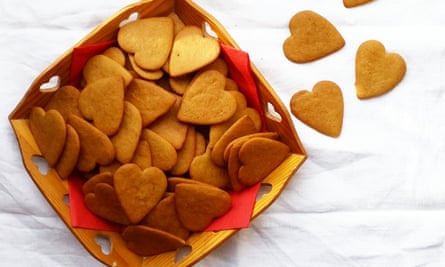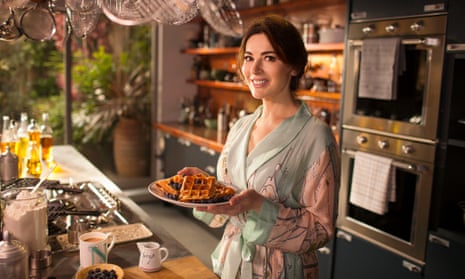Did cookbook publishers know something that the rest of us didn’t in 2016 when they were planning this year’s lists? Never has a year in global politics so clearly called for comfort eating, and food writers have delivered in ladlefuls. This has been the strongest year for cookbooks I can remember and my list of recommendations here could have been twice as long.
Comfort food, as the American food writer Emily Nunn explores in her moving and witty memoir The Comfort Food Diaries (Simon & Schuster), is not always the same as “tasteful” food. “Like the heart, the stomach wants what it wants,” Nunn writes. She recalls a former boyfriend whose taste of home was a terrible green gelatin “salad” made with cream cheese, raw cabbage, pecan nuts and lime jelly. Watching him eat it, Nunn recalls, was like “watching him realise that a person who’d stopped loving him had returned: the nostalgia, the hope, then sweet relief”. Nunn’s book is an account – with recipes – of the Comfort Food Tour of the US she took following a breakdown after her brother killed himself and her fiance left her. Without any neat epiphanies, Nunn finds that food – such as “Great-grandmother’s mean lemon cake” – is the thing that brings solace when nothing else does.
In a week of dark moods and bad weather, I took refuge in Chai, Chaat and Chutney (Mitchell Beazley) by Chetna Makan. She takes us on a charming street food tour of India, from the pantaras of Kolkata (deep fried pancakes stuffed with chicken and vegetables) to the lentil dumplings of Delhi. It’s worth buying the book just for the coriander and spinach chutney recipe, heady with ginger and garlic and creamy from the addition of a little chana dal (split chickpeas). Makan advises taking this chutney, spreading it on a soft white bread roll and placing a spiced folded omelette on top to make an omelette pav. I can’t think of a more consoling solitary lunch.
The whole subject of comfort food can feel ambivalent, as Guardian columnist Yotam Ottolenghi and Helen Goh write in their preface to Sweet (Ebury). How can we justify baking with sugar at a time when so many are suffering from Type 2 diabetes? Their answer is that it’s worth celebrating the sweet things in life with occasional treats, and they do so magnificently here, with 110 inspiring recipes. Fans of Ottolenghi’s inventive flavour combinations will not be disappointed: try pineapple and star anise chiffon cake, or walnut and black treacle tarts with sage. But Sweet also features older and simpler comforts such as Garibaldi biscuits and buttery almond tuiles. I thought there was no room for yet another baking book in my kitchen. I was wrong.

In the sea of new cookbooks, some authors struggle to find an original theme. But home cooking itself is theme enough, argues Nigella Lawson in At My Table (Chatto). This is a relaxed and inviting selection of recipes, organised with no chapter breaks, to signify, as Lawson explains, the “honest jumble” of life. I especially loved the Indian spiced chicken and potato traybake with Bollywood-pink pickled onions, and the red mussels with pasta, but I’d happily cook from this book every night.
Another glorious collection of a cook’s passions is The Modern Cook’s Year (4th Estate) by vegetarian chef Anna Jones. Her recipes are where health and comfort meet and this, the author’s third book, is thoughtfully arranged by the seasons.
If food can comfort, so can books. The Little Library Cookbook (Head of Zeus), a debut by food blogger Kate Young, brings together the two, recreating meals from her favourite books, most of them from childhood. Here is Turkish delight from Narnia and pancakes from Pippi Longstocking and apple pie from The Railway Children.
A project like this could easily descend into tweeness, but Young is grounded and engaging and her recipes are excellent. The twin joys of childhood and food are also celebrated in The Christmas Chronicles (4th Estate) by Nigel Slater, a paean to winter eating that is as reassuring and welcome as the clementine at the bottom of a stocking.
If you would rather escape the present day altogether and lose yourself in thoughts of long-forgotten meals, I recommend The French Country Housewife (Prospect Books) by Cora Millet-Robinet. This sizeable volume, by the French equivalent of Mrs Beeton, was first published in 1859 and has now been translated into English by Tom Jaine. It’s utterly fascinating, from the Beeton-like thoughts on how to run a household (“a child’s bathtub is essential”) to the recipes, some of which are bizarre (kidney mould) and some genuinely appealing (a gratin of fresh peas). I found myself daydreaming over mirabelle plum jam and orange flower cordial.

One person’s comfort is another’s discomfort. There has been much debate recently about eating insects, which offer a sustainable form of protein if we could get over the disgust factor. On Eating Insects (Phaidon) by Josh Evans, Roberto Flore, Michael Bom Frøst and Nordic Food Lab, the most thought-provoking food book I’ve read all year, approaches the issue from a fresh angle. In response to the question of whether insects can ever be delicious this study points out that two billion people already find them so. Beautifully presented, it includes essays on the ethics of eating insects, recipes – such as anty gin, spicy cricket with asparagus – and a lyrically written travelogue. Evans meets a man in Uganda for whom noodles with long-horned grasshoppers simmered in a spicy tomato sauce are as familiar as lasagne.
Lying behind all this comfort food is the darker question of why, exactly, people need to be comforted so much. Ukrainian food writer Olia Hercules begins Kaukasis the Cookbook: The Culinary Journey Through Georgia, Azerbaijan & Beyond (Mitchell Beazley) with thoughts on what it means for her to collect the cuisines of neighbouring countries that have so often been at war. While capturing the differences between the cooking of the various countries of the Caucasus, Hercules argues that the culture of the region is intertwined and that this is seen in food. Her flavours are both exciting and soothing – take the Azerbaijani dish khingal, for example, combining fresh pasta with crispy lamb, fried onions, dill, sumac and yoghurt. Hercules notes that some comfort food can be bland, whereas this dish “makes me feel safe and yet also titillates my senses”.
When we think of Syria our first thoughts are most likely far from the comforting flavours of hummus and stuffed dates. But Syria: Recipes from Home (Trapeze) by Itab Azzam and Dina Mousawi makes the case for celebrating Syrian food culture now more than ever, as part of a heritage that is still alive when so much in the country is under threat. Azzam and Mousawi pepper their book with sayings such as “Bulgar is coral but lentils are pearls” and “You are the parsley to my tabbouleh”. This extraordinary, heartbreaking volume features the stories of eight women affected by conflict in Syria alongside delicious Syrian recipes with the Middle Eastern flavours – tahini, pomegranates, za’atar – that are now so loved by British home cooks.
The project might sound distasteful, except that the Syrian women themselves all describe the food of their home as the one thing that offers solace and a connection with happier times. Fedwa was a mother of five who lost two of her sons, one to an accident at sea and the other to a sniper’s bullet. She cooks in a Damascus kitchen “as small as the happiness in my heart”. In this tiny concrete space she produces feasts, spending two days preparing a single meal, “coring vegetables, rolling vine leaves”. Her children’s favourite dinner is a dish of fish and spiced rice with sultanas and toasted almonds. Despite everything, Fedwa can take pleasure in the melted ghee she pours over the top to make it shiny.
- This article was corrected on 2 December 2017. The French Country Housewife is published by Prospect Books, not 4th Estate. (And the broken links have been fixed.)

Comments (…)
Sign in or create your Guardian account to join the discussion